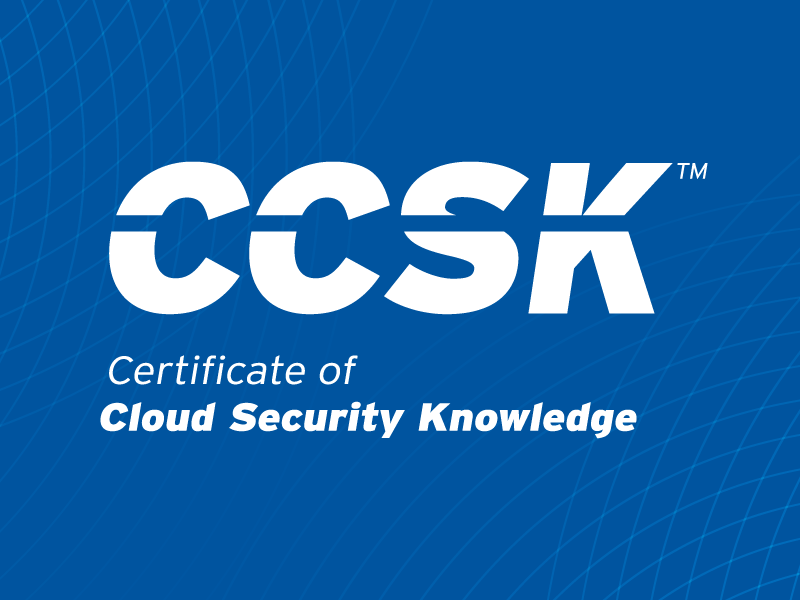Implementing CCM: Cloud Security Monitoring & Logging
Published 07/28/2025
The Cloud Controls Matrix (CCM) is a framework of controls that are essential for cloud computing security. The CCM is created and updated by CSA and aligned to CSA best practices.
You can use CCM to systematically assess and guide the security of any cloud implementation. CCM also provides guidance on which actors within the cloud supply chain should implement which security controls. Both cloud service customers (CSCs) and cloud service providers (CSPs) use CCM in many ways.
CSCs use CCM to:
- Assess the cloud security posture of current or potential cloud vendors. If a cloud vendor isn’t transparent about their security controls, the risk of doing business with them can be quite high.
- Compare vendors’ level of compliance with relevant standards like ISO 27001.
- Clarify the security roles and responsibilities between themselves and the CSP.
CSPs use CCM to:
- Assess, establish, and maintain a robust and internationally accepted cloud security program. CCM helps solidify CSPs' positions as trusted and transparent providers of cloud services.
- Compare their strengths and weaknesses against those of other organizations.
- Document controls for multiple standards in one place. CSA has mapped the controls in CCM against several industry-accepted security standards, regulations, and control frameworks.
CCM contains 197 control objectives structured into 17 domains that cover all key aspects of cloud technology:
CCM Domains
Today we’re looking at implementing the thirteenth domain of CCM: Logging and Monitoring (LOG). The LOG domain helps both CSPs and CSCs collect, store, analyze, and report on events in their cloud environments. This domain defines controls for people, processes, and technology. These controls are essential for:
- Implementing effective incident detection and incident response
- Addressing operational issues
- Identifying system anomalies
- Complying with regulatory requirements
- Auditing security controls
- Improving overall security posture and performance
The LOG domain consists of the following 13 control specifications:
- Logging and Monitoring Policy and Procedures: Establish, document, approve, communicate, apply, evaluate and maintain policies and procedures for logging and monitoring. Review and update the policies and procedures at least annually.
- Audit Logs Protection: Define, implement and evaluate processes, procedures and technical measures to ensure the security and retention of audit logs.
- Security Monitoring and Alerting: Identify and monitor security-related events within applications and the underlying infrastructure. Define and implement a system to generate alerts to responsible stakeholders based on such events and corresponding metrics.
- Audit Logs Access and Accountability: Restrict audit logs access to authorized personnel and maintain records that provide unique access accountability.
- Audit Logs Monitoring and Response: Monitor security audit logs to detect activity outside of typical or expected patterns. Establish and follow a defined process to review and take appropriate and timely actions on detected anomalies.
- Clock Synchronization: Use a reliable time source across all relevant information processing systems.
- Logging Scope: Establish, document and implement which information meta/data system events should be logged. Review and update the scope at least annually or whenever there is a change in the threat environment.
- Log Records: Generate audit records containing relevant security information.
- Log Protection: The information system protects audit records from unauthorized access, modification, and deletion.
- Encryption Monitoring and Reporting: Establish and maintain a monitoring and internal reporting capability over the operations of cryptographic, encryption and key management policies, processes, procedures, and controls.
- Transaction/Activity Logging: Log and monitor key lifecycle management events to enable auditing and reporting on usage of cryptographic keys.
- Access Control Logs: Monitor and log physical access using an auditable access control system.
- Failures and Anomalies Reporting: Define, implement and evaluate processes, procedures and technical measures for the reporting of anomalies and failures of the monitoring system and provide immediate notification to the accountable party.
You can further divide the 13 LOG controls into three categories:
- Audit Logging: Controls that focus on predicting, assessing, and maintaining the integrity of audit logs
- Policy and Governance: Controls that address the foundational aspects of logging and monitoring, such as policies, procedures, and scope
- Security Monitoring and Alerting: Controls focused on monitoring logs, detecting anomalies, and responding to security events
LOG Shared Responsibilities
Under the Shared Security Responsibility Model (SSRM), both CSPs and CSCs share responsibilities for implementing logging and monitoring controls. CSPs are typically responsible for logging and monitoring the underlying cloud infrastructure, such as network and system operations. CSCs, on the other hand, manage logging and monitoring within their deployed applications and services.
CSPs are responsible for the security of the cloud. This means implementing robust logging mechanisms. At the infrastructure level, they are responsible for maintaining the logging infrastructure, ensuring log integrity, and providing comprehensive monitoring tools. More specifically, CSPs are responsible for:
- Implementing logging, monitoring, and auditing capabilities across the underlying cloud infrastructure
- Ensuring the secure storage, production, and retention of audit logs—safeguarding them from tampering or unauthorized access
- Providing synchronization of the system clock across their cloud services to maintain consistent and accurate timestamps in audit logs
- Offering compliance frameworks, tools, and guidance to help CSCs implement logging and monitoring controls aligned with regulatory standards
CSCs are responsible for security in the cloud. This means they need to properly configure and utilize logging capabilities provided by their CSPs. They need to actively monitor and respond to security events relevant to their workloads. More specifically, CSCs are responsible for:
- Defining the logging scope and requirements for their applications and data
- Integrating application and infrastructure logging with CSP capabilities to create a comprehensive view of the environment
- Configuring security monitoring and alerting for cloud resources
- Managing access controls to ensure accountability for their audit logs and prevent unauthorized access or tampering
- Regularly reviewing audit logs
- Identifying anomalies and security events
- Responding promptly to risks and compliance issues
All in all, shared responsibility in logging and monitoring ensures effective visibility and security in cloud environments. CSPs provide the essential tools, infrastructure, and compliance support for logging and monitoring. CSCs take an active role in configuring and using these tools to protect their applications and data. Both parties must fulfill their roles to create a secure and resilient cloud ecosystem.
The Risks of Not Implementing LOG Controls
When organizations don't properly implement logging and monitoring controls, there can be serious implications for their security posture.
The first and perhaps most concerning risk is delayed incident detection and response. Without proper logging and monitoring, security breaches can go undetected for months. In some cases, attackers maintain persistence in networks for extended periods simply because the organization lacks adequate monitoring capabilities.
The second major risk involves compliance and audit failure. In today's regulatory environment, this is particularly critical when you are dealing with GDPR, HIPAA, and other regulatory frameworks. Remember, logging requirements aren't optional.
The third risk is data compromise. When organizations don't properly protect log data, it becomes a target. Attackers know that if they can tamper with logs, they can effectively cover their tracks. Even worse, sensitive log data can itself become a source of exposure, potentially revealing system vulnerabilities or sensitive operational details.
LOG Implementation Guidelines to Address These Risks
First, we need to discuss centralized log management. This is absolutely crucial in today's complex cloud environment. You need a unified platform that can ingest, process, and analyze logs from all your cloud resources. By having centralized log management, standardizing log formats, and enabling real-time streaming, you create a comprehensive view of your entire cloud infrastructure.
Next, log protection and retention directly addresses the risks previously discussed. Strong encryption isn't optional anymore—it's mandatory, especially with quantum encryption coming.
Third, automated monitoring and alerting. In the cloud, manual monitoring simply doesn't scale. You need an automated system that can continuously monitor your infrastructure with well-defined thresholds. This includes establishing baseline behaviors—you can't detect anomalies if you don't know what normal looks like.
Finally, access control and accountability. This is about protecting the protectors. Your logs are only as secure as the access controls around them. Implement strict rollway access, enforce strong authentication, and maintain detailed records of who accessed what and when.
A Final Word
Don't forget the importance of comprehensive and actionable logging for sensitive data. In a regulated environment, implementing robust logging mechanisms helps meet compliance requirements while still benefiting from a CSP-managed service.
Effective cloud security in the LOG domain balances visibility, automation, and compliance. By applying these principles, you are monitoring data, but you are also empowering your business to detect, respond, and recover from incidents effectively.
Finally, make sure to check out the CCM and CCM Implementation Guidelines documents. All CSA documentation is free to download and use. Learn how to implement the other CCM domains by reading the rest of the blogs in this series. Be on the lookout for the next installation: Security Incident Management, E-Discovery, & Cloud Forensics.
Unlock Cloud Security Insights
Subscribe to our newsletter for the latest expert trends and updates
Related Articles:
Agentic AI Security: New Dynamics, Trusted Foundations
Published: 12/18/2025
AI Security Governance: Your Maturity Multiplier
Published: 12/18/2025
Enhancing the Agentic AI Security Scoping Matrix: A Multi-Dimensional Approach
Published: 12/16/2025
Micro-Segment the Metal: A Zero Trust Field Guide for Physical Hosts
Published: 12/12/2025





.png)
.jpeg)
.jpeg)
.jpeg)
.jpeg)